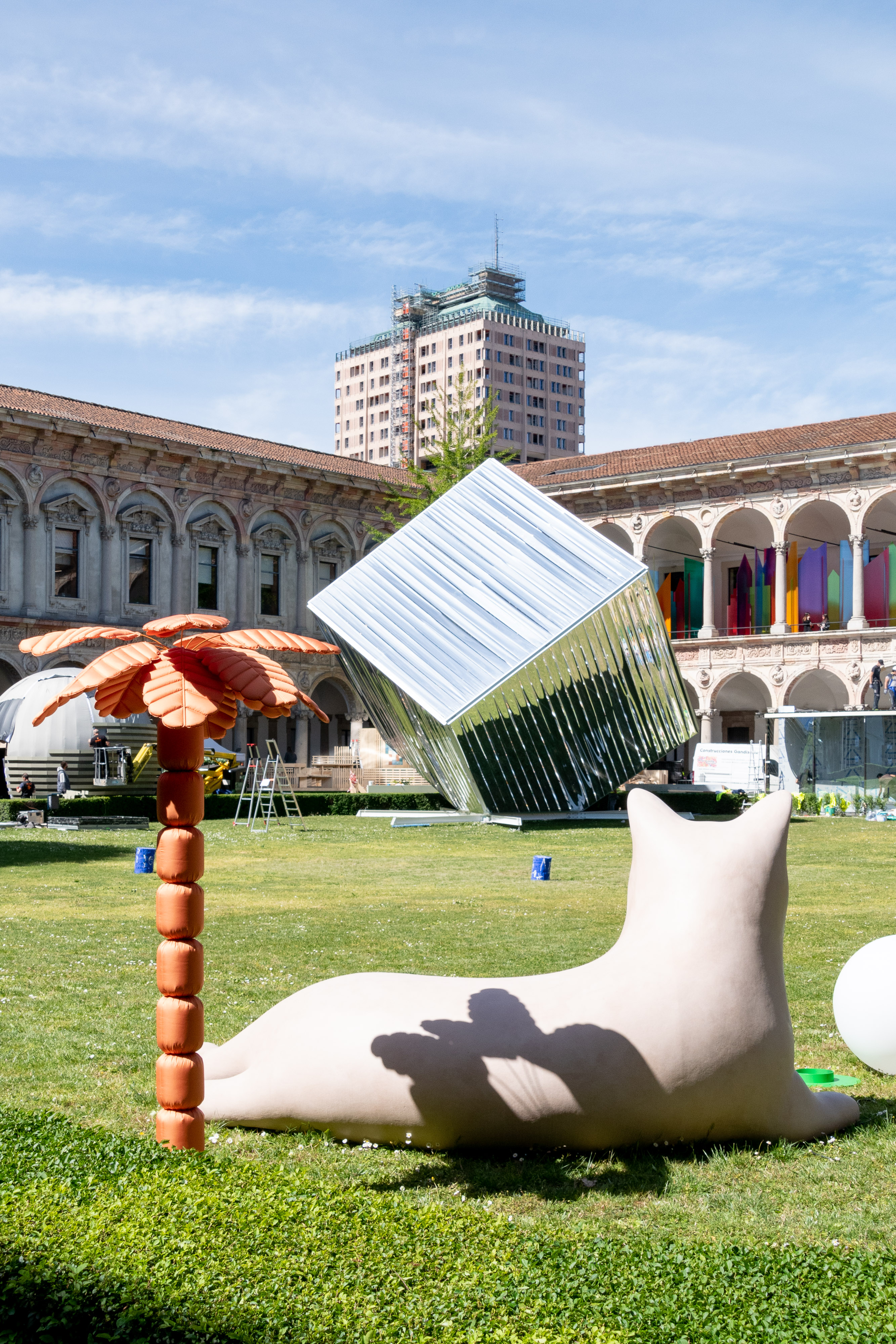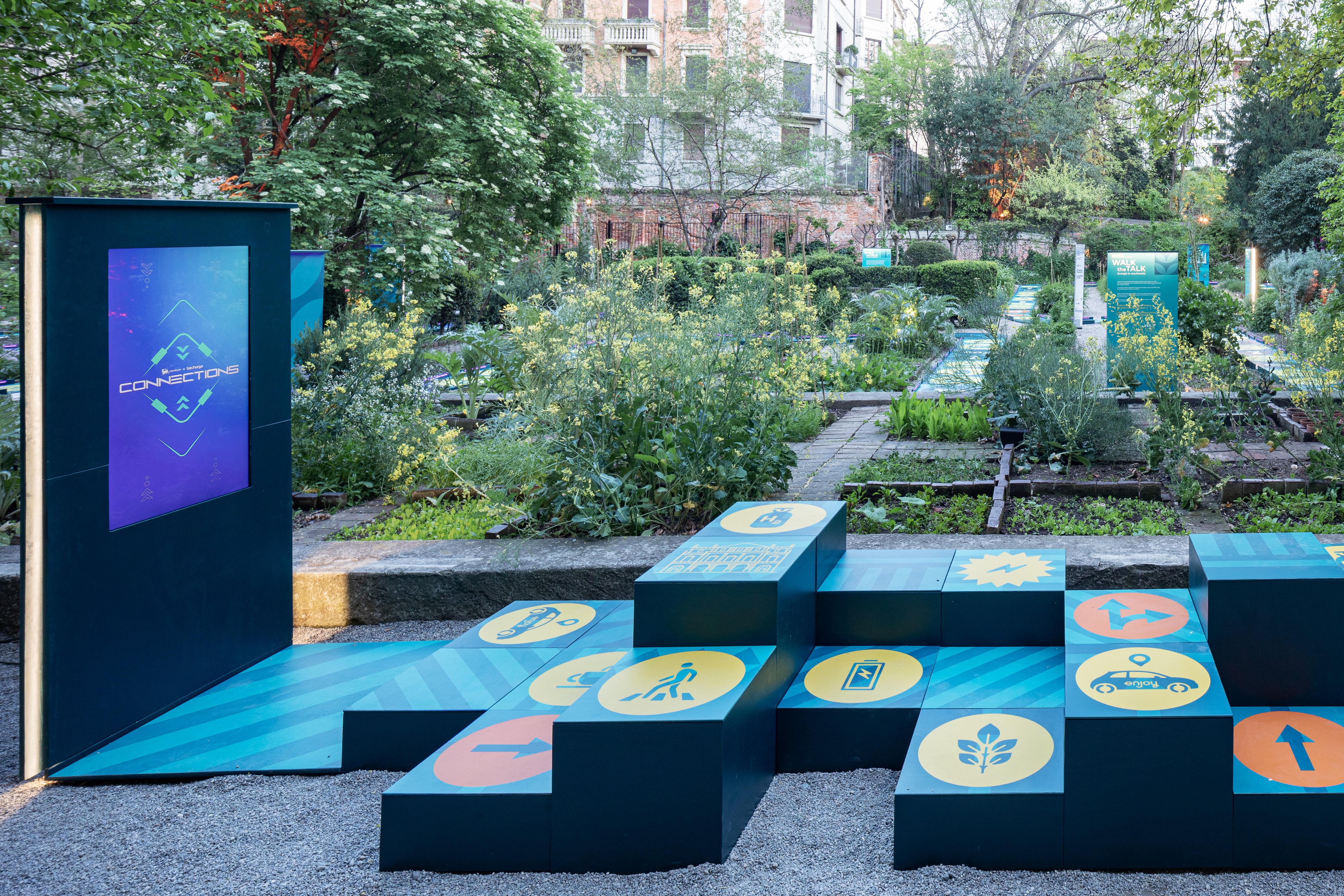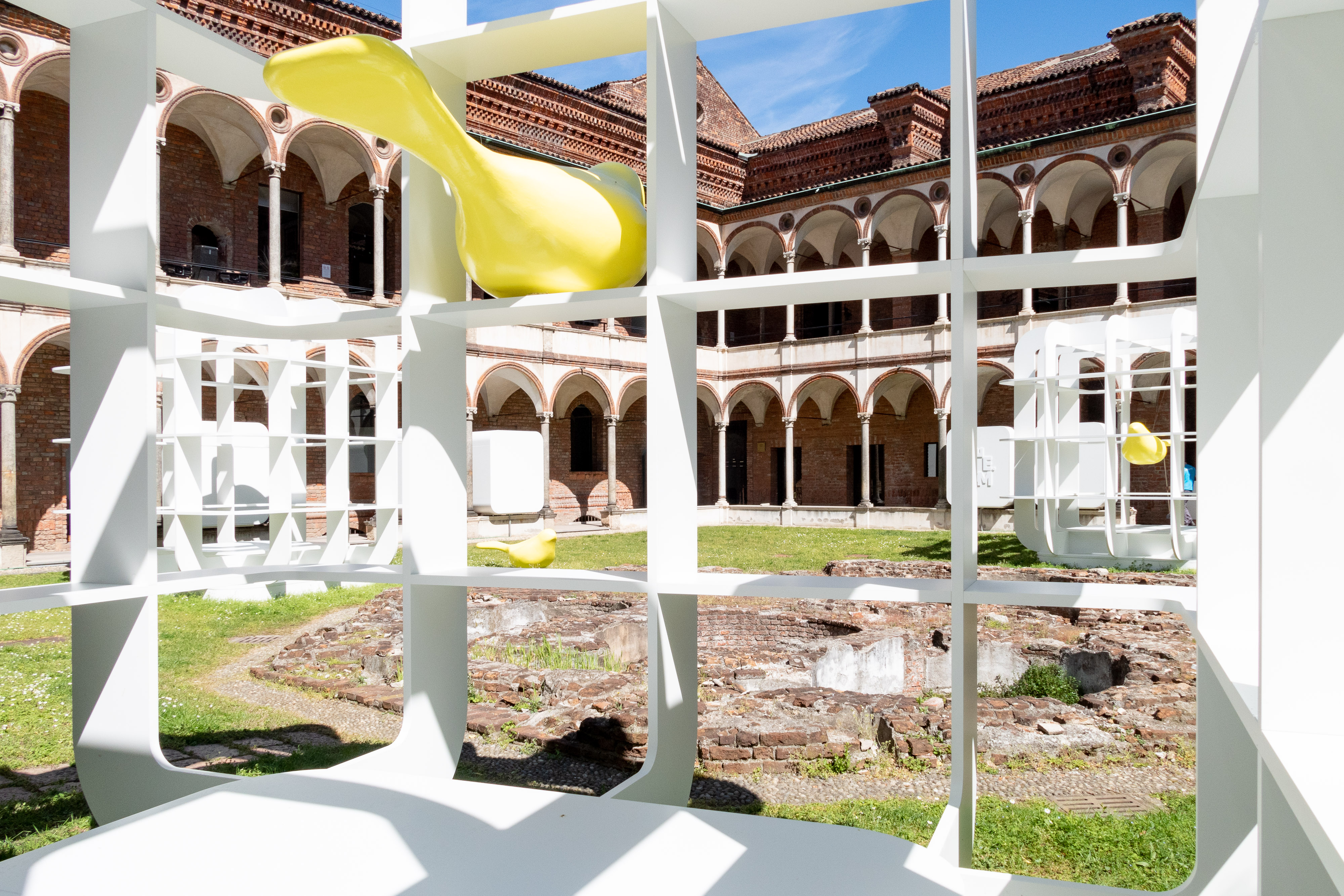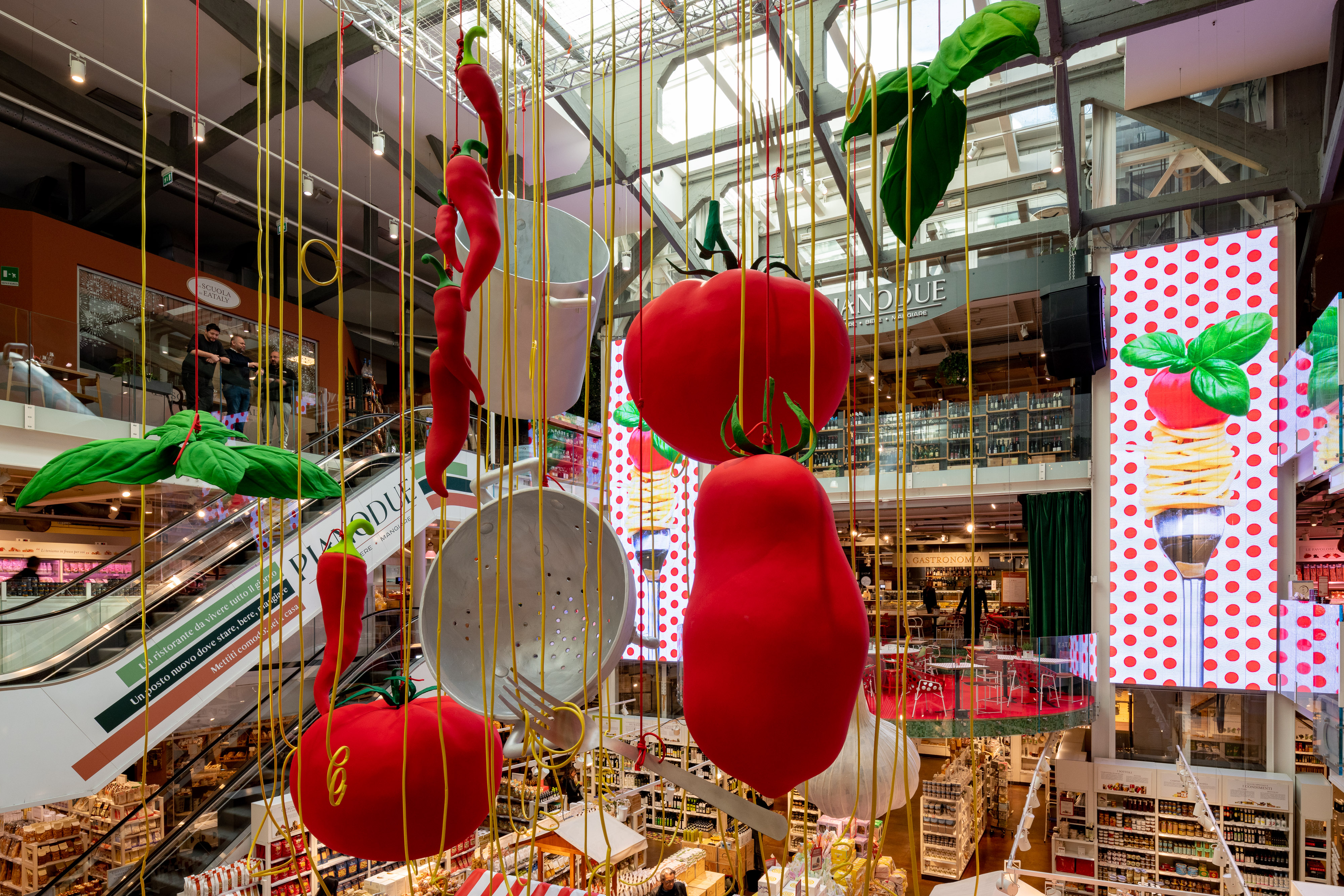- Home
- Media
- News and press releases
- 2023
- Interni presents the exhibition event “Design Re-Evolution”: design as evolution, revolution, fusion and sustainability
Interni presents the exhibition event “Design Re-Evolution”: design as evolution, revolution, fusion and sustainability
From April 17 to 26, over 40 installations across six locations in the heart of the city: the University of Milan, the Eni Space at the Brera Botanical Garden, the Audi House of Progress at Portrait Milano, Eataly Milano Smeraldo, De Castillia 23 by Urban Up | Unipol and the Torre Velasca.
The magazine engaged over 40 architects, designers and artists in collaboration with prestigious businesses, start-ups and institutions
Over 40 creative projects by a line-up of more than 40 designers from Italy and around the world across 6 iconic locations in Milan, which will play host to 9 days of events, meetings, and talks with leading figures in design culture and much more. These are the numbers that matter for INTERNI Design Re-Evolution, the eagerly awaited exhibition-event created by INTERNI, the Mondadori Group interiors and contemporary design magazine, and curated by Gilda Bojardi. The events take place from 17 to 26 April in the courtyards of the University of Milan, the Eni Space at the Brera Botanical Garden, and at Portrait Milano, home of the Audi House of Progress.
This year, INTERNI, a long-time champion of new spaces for creativity, is adding Eataly Milano Smeraldo, De Castillia 23 by Urban Up | Unipol and the Torre Velasca to the three “institutional” locations.
In collaboration with the City of Milan, INTERNI Design Re-Evolution is one of the main initiatives of Milan Design Week and FuoriSalone 2023, created in 1990 by the magazine’s editor-in-chief, Gilda Bojardi, and universally recognised as the leading event for international design and architecture.
INTERNI Design Re-Evolution aims to offer a collective and multidisciplinary reflection on the role of evolutionary thinking as a design tool for new territories, both known and unknown, physical and digital, present and future.
“The Design Re-Evolution is a revolution, because it aims to redevelop the land, the objects that inhabit it, the materials with which they are made, and the energy used to create them”, explains Gilda Bojardi, editor-in-chief of INTERNI. “But it is also evolution, because it develops through a synergy between various disciplines – such as science, art and set design – fostering positive exchanges between individuals, businesses, institutions, and, of course, the citizens. And it is a process, in that it is a way of conceiving, producing and sharing ideas in order to reach a new configuration of the spaces in our lives. The Design Re-Evolution therefore approaches the home in the sense of a ‘mirror for the soul’, in the words of Mario Praz, encouraging the circulation of information and contacts on possible circular economy solutions. The exhibition event thus helps to build new landscapes to promote new interaction between people and environment, in a profound dialectical relationship with nature”.
But INTERNI Design Re-Evolution also explores territories that are still beyond our knowledge, from the Metaverse to the farthest universe. Because it is in this realm of creativity, where we may well feel out of our comfort zone, that the empathy inherent to design becomes a tool which strengthens imaginative power and the ability to interpret human emotion. Combined with solid professionalism and design ethics, these qualities allow us to understand, conceptualise and experience the evolution of our planet.

The three co-producers of the exhibition eventi: Audi, Eni and Whirlpool
The main sponsors of INTERNI Design Re-Evolution are three premium brands active in the field of sustainability: Audi, a leading car manufacturer with a comprehensive commitment to providing sustainable mobility, has innovation and progress in its DNA; Eni, an integrated energy company, launched a new strategy in 2020 which will allow it to reach its goal of zero net emissions by 2050 and to supply a range of totally decarbonised products, combining environmental and financial sustainability and focusing on technological leadership built over years of research and innovation; Whirlpool is a global leader in domestic appliances, thanks to its solutions with cutting-edge design created to improve the quality of domestic life. Each co-producer is presenting a high-impact installation with their own interpretation of the theme of the exhibition event.
At Portrait Milano, Corso Venezia 11 _ Audi House of Progress
Human values are central to The Domino Act, an installation representing Audi‘s vision of sustainable mobility. A circular structure of 22 monoliths encloses and protects the Audi skysphere concept car, their multiplying reflections acting as a reminder of the importance of working together. Located in the magnificent Piazza del Quadrilatero of Portrait Milano, Milan’s exclusive new hotel complex occupying the spaces of the former Seminary of the Archbishop in Corso Venezia, it was designed for Audi by Gabriele Chiave with Controvento. It brings an artistic sensibility to the principle of the Sustainability Domino Act, highlighting how decisive action in a strategic area can trigger a virtuous knock-on effect. The key presence of the Audi skysphere concept, demonstrating the perfect blend of emotion and technology with people at its centre, recognises research and progress as defining factors in the Brand’s strategy and its roadmap to decarbonisation.
At the Brera Botanical Garden – Eni Space
The Brera Botanical Garden is transformed into Eni Space, hosting Walk the talk – Energy in motion, a large interactive game. With one of Milan’s most beautiful gardens as its backdrop, the design tackles the FuoriSalone “Future Lab” theme through an intriguing giant game board all about the evolution of mobility, representing the activities and vision of Eni Sustainable Mobility. Developed by Italo Rota and CRA – Carlo Ratti Associati together with the Blob Factory Gaming Studio game designer collective, Walk the talk – Energy in motion explores themes such as the shift to more sustainable transport solutions, vehicle sharing services, and producing fuel from renewable raw materials. In so doing, it invites the public of FuoriSalone and INTERNI Design Re-Evolution to reflect on the future of our city. Each player chooses a path to follow through the installation, offering an interactive way to discover everyday actions and practical solutions for increasingly sustainable mobility. Entrances and exits punctuate the trail, which runs along the leafy pathways of the Botanical Garden, over an area of 3500 square metres with roughly 400 illustrated boxes. The boxes absorb sunlight during the day and convert it to light in the evening, creating lighting effects that change with the time of day.
At the University of Milan, Whirlpool with “The Synesthetic Swirl”
Light, colour, reflections and visual distortions abound with The Synesthetic Swirl, the spiral display in the Cortile d’Onore at the University of Milan, designed by Odile Decq for Whirlpool, the exhibition’s co-producer. Reproducing the geometry of a vortex and inspired by the archetypal image of the spiral, The Synesthetic Swirl prompts a journey and invites us to explore our sixth sense: intuition. Inside its fully immersive and engaging interior, whose exterior is just as appealing and intriguing, the installation offers the possibility of a ‘before’ or an ‘after’. The reflective effect of the mirrors creates a synesthetic vortex which can represent the dualities of an opening or an awakening, an oscillation, a step forward or backward.

Installations and designers: the key figures of Interni Design Re-Evolution
The great INTERNI exhibition event was created with the aim of initiating and multiplying connections and relationships: a virtuous system between creatives, businesses, distribution networks who have the fundamental need to connect people and ideas from different cultures and backgrounds. In collaboration with businesses, multinationals, start-ups and institutions, there are more than 40 designers who have made over 40 creative projects (installations, displays, design islands, micro-architecture and macro-objects, all site-specific) to explore the theme of this year’s exhibition.
The spaces of the University of Milan provide the setting for a series of impressive installations.
In the Cortile della Farmacia, Amazon presents The Amazing Playground: an interactive immersive space featuring Swing, an installation designed by Stefano Boeri Interiors. It takes the form of a special swing inspired by early twentieth-century Spanish Surrealism and the Circo Americano in Madrid, and offers a playful counterpoint to the abstract rhetoric around sustainability. Swing supports Parco Italia, a national urban forestation project promoted with Amazon Italia by Stefano Boeri Architetti and AlberItalia, founded to improve and implement Italy’s natural capital and its biodiversity. In addition to interacting with the installation, the public can also discover a selection of certified Climate Pledge Friendly products available on Amazon.it and displayed around the courtyard.
In the Cortile del ‘700, The Impossible Machine, a metal sculpture designed by Piero Lissoni for Sanlorenzo, combines high technology with skilled workmanship, giving physical form to the theme of sustainable yachting. It presents a large mechanism whose parts move thanks to the new hydrogen system that Sanlorenzo is developing to power its craft, in partnership with Siemens Energy. The backlit platform on which the metal installation rests highlights the mechanism’s propellers and cogs, while the fine vapour surrounding it reproduces the effect of a turbine powered by a fuel cell system.
A number of different projects have been created in the Cortile d’Onore. These include A Theatre to Save the Planet, an itinerant theatre created by Andrea Boschetti in collaboration with Ana Lazovic from Metrogramma studio with Mirage designed to promote the values of sustainability, solidarity and responsible innovation. It consists of containers recovered from the ocean, which become a place of meditation and participation, hosting events each day dedicated to the theme of sustainability (partners of the Save the Planet project).
A modern Cabinet of Curiosities, by Annabel Karim Kassar, is an interactive installation which invites the visitor to reimagine their place in the natural order and to go beyond mere viewing, exploring how architecture can change our emotional balance and the intimate human experience.
The Oasis. Microarchitecture by Massimo Iosa Ghini, enveloping and protective, demonstrates an approach to design inspired by plant organisms, resulting in a space with a beating heart which places man and nature in dialogue through natural light and materials, the movement of the air, and sensory perception.
Berlin studio Topotek 1 – in collaboration with the Landscape Festival of Bergamo – Masters of Landscape – with Grow together, Grow green / 10k+ has designed an experience to be lived and shared, a collective action divided into three concepts: deconstruction, activation and green growth. The structure, which can be dismantled and reused, acts as a pick-up point for a collection of plants that visitors are invited to take home and look after. The Nutura pavilion, by Benedetta Tagliabue – EMBT Architects, built in collaboration with Roca, is made from wood and ceramic and offers a multisensory exploration of nature and Mediterranean architecture, with lattices and shutters creating shadow effects, material textures, and changing views. The pathway leads to a plaza in which to relax and enjoy the view of the Cortile: in keeping with the Re-Evolution theme and the value of sustainability, all the materials used will be disassembled, recovered and used for other projects.
The Loggiato Est hosts Discover(y) lightning by Mario Cucinella with Artemide: a bright and heartfelt tribute to Ernesto Gismondi, founder of Artemide, achieved through a series of pendant lights which cloak the Cortile del Filarete in red, shaping its spaces and framing details. The work enhances the quality of the spaces through the use of Integralis, a patented lighting technology which sanitises and inhibits the growth of bacteria on the surfaces it lights.
Also in the Cortile d’Onore, English artist Ian Berry presents The greatest story ever worn, a tribute to 150 years of the iconic Levi’s 501s; Stone Pavilion by Brazilian architect Vivian Coser showcases the country’s stone production with a focus on eco-friendly processes and materials, in collaboration with It’s Natural, Centrorochas, ApexBrasil.
Fidenza Village presents MOAI sculptures by street artist duo Urbansolid, offering a reflection on modern times by reinterpreting ancestral history through the contemporary language of street art. Operae by Gianni Lucchesi for Giannoni&Santoni and the Hangar gallery is a stone sculpture of a life-sized seated figure overlooking the Cortile d’Onore from the top of a 13-metre totem made up of modular cubes in lightweight concrete.
Symbolising the perfection of architecture, standing on the central lawn is an enormous cube in reflective strips – Momentum – by Ma Yansong and Andrea d’Antrassi/ MAD Architects produced in collaboration with AXA IM Alts.
Lastly, two totems, one created from layers of construction materials and the other formed from a slim metal frame – Tangibile & Intangibile – presented by One Works with Mapei and Ica, aims to find a balance between architectural know-how, through the reuse of materials, and the discovery of new languages to express design, such as virtual reality and the Metaverse.
Temporal, the presentation organised by ApexBrasil, is two-fold: a spherical, cocoon-like installation 6 metres in diameter covered in real moss, in the Cortile d’Onore; and an exhibition of products curated by Bruno Simões, displayed along the Portico Richini and Portico San Nazaro. It represents the vitality of contemporary Brazilian design in its various forms, regions and characteristics, and reflects on production driven by sustainability and a focus on the environment and nature.
As a long-standing advocate for his ideas on architecture and design, in the Cortile dei Bagni Simone Micheli presents Free.Dom, a metaphor for time and the approaches we can take to life. Through companies, who are exploring new interpretive possibilities thanks to his work, Micheli created three large structures representing “cages” in a large mesh. Two of these house a stylised bird, while the third is empty. Next to it is the bird which has flown out. The meaning is that only those who truly wish and choose to free themselves from stereotyped patterns, from system crises, from content stalemate, from clichés and conservatism, can do so.
There are also numerous installations in the portico of the Cortile d’Onore: Seating Experiments With Spanish Tiles by Tomás Alonso Studio for Tile of Spain, Metamorphosys by Roberto Banfi with Studeo group for Itelyum, and Farfalle by Ludovica Diligu with Labo.Art, as well as Flow by Francesco Forcellini with Besenzoni, Studio Nomade d’Artista by Sergio Fiorentino – Studio Gum, New Horizons by Mandalaki for Halo Edition, Sit on the wor(l)d by Marco Nereo Rotelli for Ever In Art and Giardino Segreto, which is the exhibition of the results of the 4th edition of the contest “Design. A journey through Italy and Spain”, curated by Carmelo Zappulla of External Reference for the Italian Embassy in Madrid.
In the Aula Magna great hall, Time After Time by Gianluigi Colin with Galleria De Ambrogi presents an installation consisting of hundreds of metres of fabric used to clean newspaper printing presses; authentic objets trouvés, secular shrouds, loaded with the memory of endless erased stories, hanging eleven metres high. This work prompts us to question the quality of the information system, collective memory and its dissolution. A secular temple of knowledge, the University is the natural home for a project such as this because, as Aldo Colonetti says, “like architecture, design must never forget that art is the foundation of every design-related discipline”.
Material textures are the focus of Acrylic Skyline by Jacopo Foggini with Dr. Gallina, a polychrome skyline as a “tribute to Alessandro Mendini” on display along the Loggiato Ovest. The visitor is guided by the light filtering through the multiwall polycarbonate sheets in a rainbow of colours, chosen to offer an impression of fluidity. Foggini invites us to reflect on the materials of the future and prompts positive thinking on the “eternal” nature of plastic.
With L’arte del colore by Francesca Grassi of Studio Italo Rota with Boero, the Portale Hall Aula Magna becomes a modern interpretation of the rainbow, achieved using the colours of the new Boero colour system, 1831 – Il colore italiano.
The North and South doorways of the University host the installation Re-Connection: Alberto Caliri, creative director of Missoni Home Collection, offers a series of small rabbits designed to prompt our memories and reconnect us with emotions and imagination.
CaberlonCaroppi studio with Pedrali, Zambaiti Parati for Concreta explore the theme of Design Re-Evolution with Liminal, by furnishing the exhibition’s press room with unique furniture customised for the occasion, while Urban Stage by Parisotto + Formenton Architetti with Cimento offers a concrete look for outdoor relaxing with an urban feel with Outdoor Lounges.
Worth noting is that many of the installations in the exhibition were created with the idea of being reused, whether fully (such as the Amazon swing, linked to biodiversity, or the containers of Mirage, with Save the Planet), or partially, to create new settings and objects. INTERNI participates in the Urban Economy, Fashion and Design Project by the City of Milan, which transforms the exhibits of Milan Design Week into a concrete possibility of regeneration and reuse, in line with the principles of the circular economy.

New sites
The traditional institutional sites of INTERNI Design Re-Evolution are joined this year by other iconic locations in the city: Eataly Milano Smeraldo, De Castillia 23 by Urban Up | Unipol and the Torre Velasca.
At Eataly Milano Smeraldo, Paola Navone Otto Studio are celebrating Italian identity with 100% Pasta: a thorough examination of the quality of good food, from harvest and preparation to tasting. Tomatoes, pots and pans, garlic, chillies and spaghetti all made by the Viareggio Carnival Foundation hang from the ceiling in an aerial installation at Eataly Smeraldo, over the stage at the centre of the store. The stage has been decorated for the occasion in tomato red, and furnished with modern chairs and tables in red, white and green, referencing the ingredients of the quintessential Italian dish, pasta with tomato sauce. And not just any recipe, but the dish Paola Navone’s grandmother used to make for her, selecting the ingredients with care and love. The “100% Pasta” installation will be presented to the public on Thursday April 20, at 6pm, on the stage at Eataly Smeraldo, with a food performance which will see Paola Navone talk about her installation and the link between food and design, sharing the story of her “Pasta Paola”, alongside an Eataly chef who will make it for those present.
The message conveyed in the Isola district consists of just two simple yet alarming words: H2o HELP. On the lawn in front of De Castillia 23, a building redeveloped by Urban Up – Unipol and owned by the Group, an installation by Maria Cristina Finucci greets visitors with a sort of living being, 70 metres long and formed of a series of “water cushions”. Those sitting on it may not immediately realise that just a few steps away, this living being is gasping for air, showing everyone its struggle to survive. Through its agony, it attempts to communicate humanity’s distress in light of one of the most serious issues it is facing: a lack of water.
Once again, 66 years after it was built, with QR Code: Quick Re-Evolution Code, the Torre Velasca is the mouthpiece for a Re-Evolution, acting as the gateway to a virtual world offering new levels of perception to augment reality. Hines entrusted the project to the creative flair and talent of designer Elena Salmistraro. The project is an innovative digital experience which introduces an extraordinary foray into new ways of experiencing places, freeing their revolutionary communicative potential. As the name suggests, a QR code is key to the installation. Visitors use it to access a specially designed digital space, dedicated to discovering this iconic Milanese building. The QR Code will be available in the FuoriSalone Guide, on the INTERNI channels, on the website www.torrevelascaqrcode.com, as well as on 80 floor stickers positioned strategically around the city.

The Interni system
The INTERNI integrated system of communication multiplies and reiterates its role as a key source of information for the world of design. Two printed publications (INTERNI and the FuoriSalone Guide), two digital publications (INTERNI King Size and the legendary FuoriSalone Guide), one major event (INTERNI Design Re-Evolution), INTERNI online (website and social media) and Interni Design Journal – with insights and videos which will be delivered through a newsletter system – provide all the tools for keeping up to date in real time on all the latest design trends, news and previews.
Now in its 33rd edition, the FuoriSalone Guide is the essential handbook for anyone who wants to discover and explore the increasingly packed calendar of Milan Design Week, through the annotated presentation of 350 events involving the companies, designers and architects participating in FuoriSalone, organised both day by day and in alphabetical order. The guide, which is available free with the April issue of INTERNI in Milan, and in all the showrooms, institutions, museums and other locations participating in FuoriSalone 2023 (as well as at the fair itself), can be accessed online (both on tablet and smartphone), and includes an interactive map.
The strength of the brand is also clearly visible throughout the city: Design Re-Evolution involves a major street advertising campaign which includes 15 banners displayed at the main entrances to Milan and in the historic centre, 1000 flags at the locations of the events mentioned in the FuoriSalone Guide, as well as 60 digital points in the busiest areas, 10 retro shuttle buses, customised news stands in the historic centre and in airports, window displays and LED walls(Mondadori Duomo bookshop in Piazza del Duomo and Rizzoli Galleria in Galleria Vittorio Emanuele).
For all information www.internimagazine.it